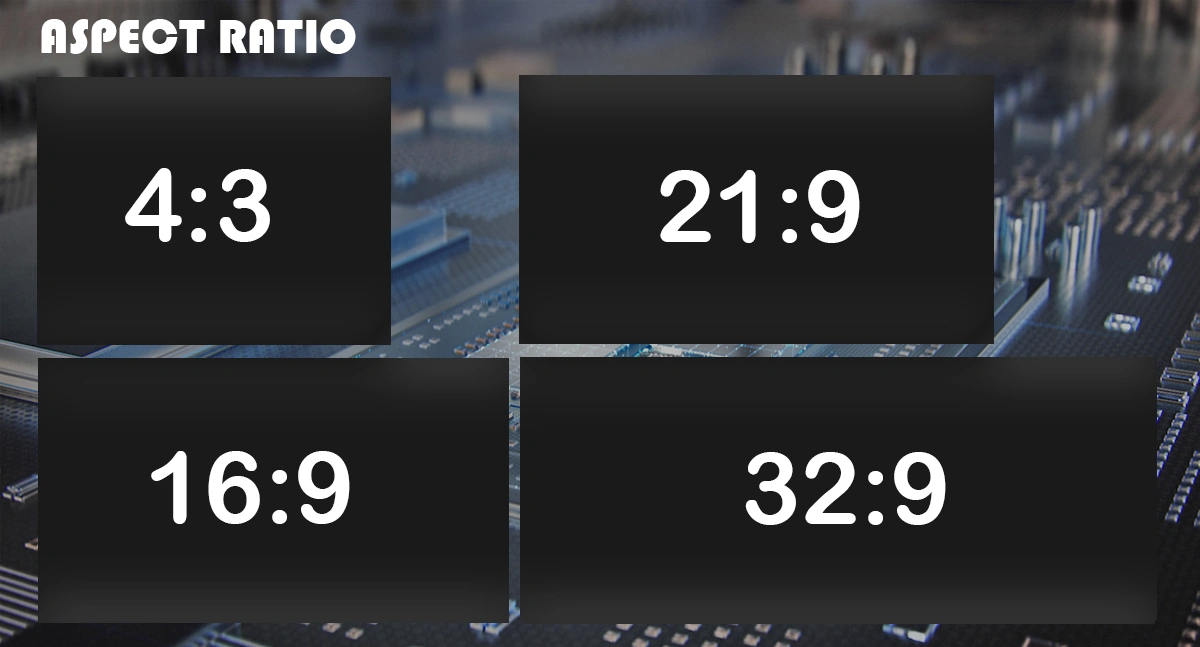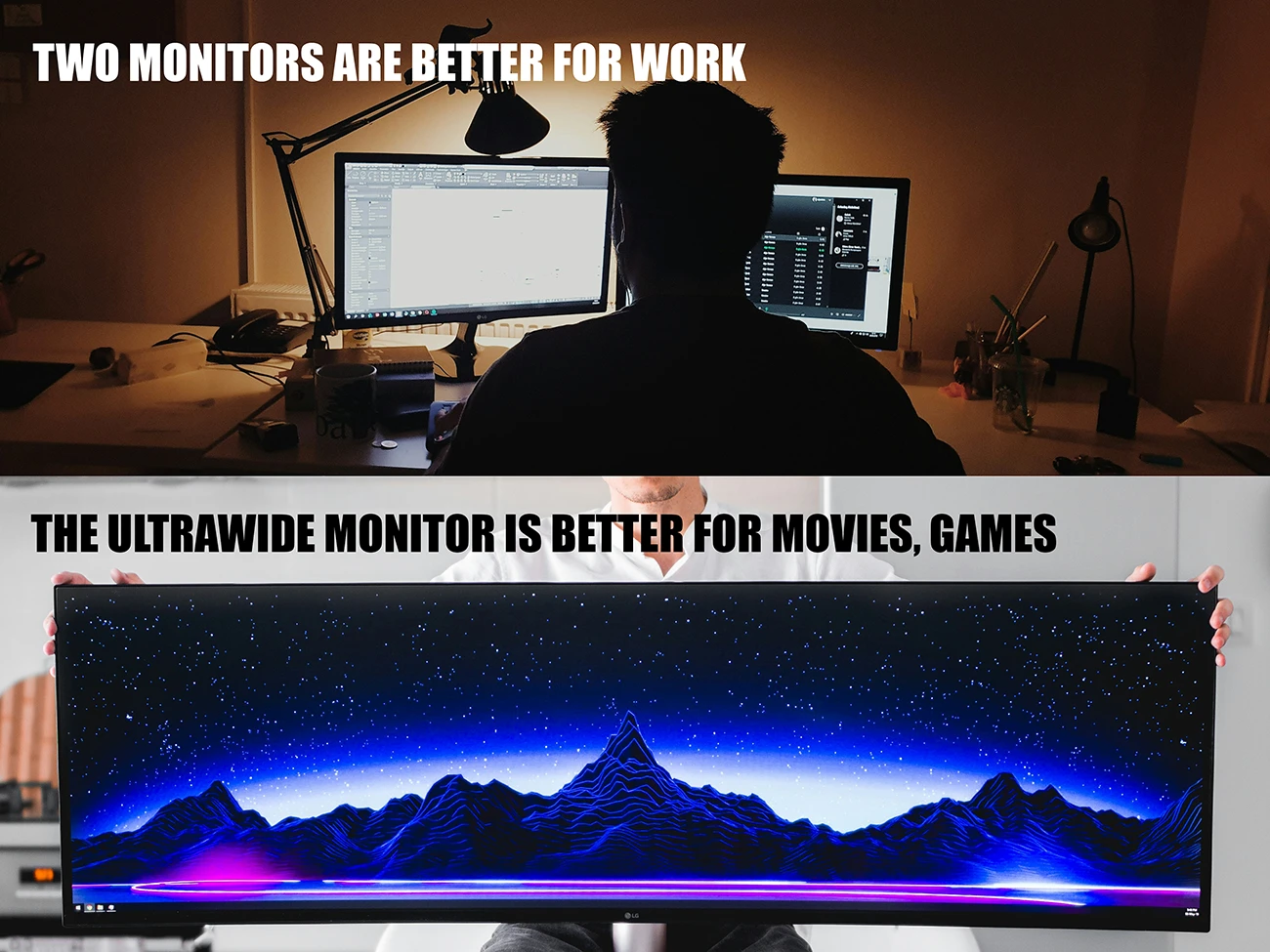Two Monitors Or One Ultra Wide Monitor: Which Is Better?
When it comes to choosing between an ultrawide monitor or dual monitors, which one best meets your needs?
Today, we’ll delve into this comparison with all the detailed and exciting information it deserves, comparing these monitor configurations to help you determine which setup suits your personal needs better.
Overview of Ultrawide and Dual Monitors
Let's introduce our competing monitor configurations.
An ultrawide monitor refers to a display with a 21:9 or 32:9 aspect ratio (compared to the standard widescreen aspect ratio of 16:9). These monitors are typically quite large to fit this form factor, often comparable to two smaller monitors merged together in terms of form if you pay close attention to their height.

Ultrawide Monitors vs. Dual Monitors – Which is Better?
Price Comparison
In terms of price, dual monitors have a significant advantage, especially if you're purchasing high-quality monitors based on factors like resolution, color accuracy, etc. Ultrawide monitors, on average, are much more expensive with the same features compared to a pair of identical monitors. This is problematic when even entry-level ultrawide monitors cost over $300 USD (compared to entry-level 16:9 aspect ratio monitors available for $115 USD).
Winner: Dual Monitors
Desktop and Professional Use
For desktop and professional use, it's crucial to maximize screen space efficiency. Both "ultrawide" and "dual monitor" setups provide much more screen real estate for work, and in the case of ultrawide monitors, they offer more space for comfortably splitting windows on the screen for multitasking. However, dual monitors are much better suited for desktop use.
Besides offering additional window configuration options, having two monitors allows you to use one or both in full-screen applications without worrying about interfering with the other. Ultrawide monitors offer screen space, but true dual monitors still provide greater flexibility – and at a lower cost.
Dual monitors allow you to buy two different monitors, even if they are the same size. This is extremely practical if you need color accuracy for checking your project but don't want to spend extra money on both monitors (it’s not necessary).
You can also purchase two monitors of the same size: one with a 4K resolution and the other with a WQHD resolution. This is a popular solution among creatives who work with Adobe CC, 3D, and other content creation software that has a complex user interface with many menus, timelines, palettes, icons, and the like.
Much of your software interface will be crystal clear on the WQHD monitor, and you can place footage with accurate color reproduction on the second 4K monitor – no interpolation needed.
Winner: Dual Monitors
Ultrawide Monitors vs. Dual Monitors – Conclusions
In conclusion, neither dual monitors nor an ultrawide monitor are always the best fit for every use case.
As is often the case, it will depend on your workload:
- Choose an Ultrawide if you play a lot of games or want to watch movies without horizontal bars (read: for entertainment).
- Choose Dual Monitors for increased productivity and the freedom to select different (but same-sized) monitors to cut costs and improve your professional and desktop workloads (read: for work).

Frequently Asked Questions
Who makes the best ultrawide monitors?
- For gaming: The best options are from Samsung, BenQ, or Alienware.
- For professionals: Consider models from Eizo or Dell.
What are the disadvantages of dual monitors?
There are not many disadvantages to dual monitors, aside from the need for more space and power to operate them. Dual monitors can cause minor performance drops in games and input lag when something is running on the additional monitor while gaming on the primary display. However, this is not a significant enough drawback to deter most gamers from using 2+ monitors.
Ultrawide format: 21:9 or 32:9?
Ultrawide can be either 21:9 or 32:9, though 21:9 is more common. This aspect ratio is also more prevalent in cinema if you plan to watch movies on an ultrawide monitor.
Are ultrawide monitors worth their price?
If you are a gamer or particularly an avid movie enthusiast, I think Ultrawide might be an attractive option for you.
Their super-immersive wide field of view can be great for such content and can easily look better than trying to use multiple monitors for the same panoramic image.
However, if you are an average person or a professional, I think you will be happiest if you choose two monitors.
Dual monitors are not only, on average, cheaper but also generally offer you a much wider range of options (in terms of panel type, image quality, etc.) than the relatively limited market for ultrawide monitors.

Building the Ultimate Computer for SketchUp Work
Which CPU is The Best for Fast Rendering of 3D Scenes in 2025
5 Best GPUs for Graphic Design Professionals
The Best Laptop for 3D Modeling and Rendering in 3ds Max
Choosing a Computer for GPU Rendering

Latest Discussions
Thank you so much!! 
Beautifully composed scene! The sense of depth and lighting are just perfect. ✨
Harika bir sahne kurgusu! Derinlik ve ışık kullanımı mükemmel. ✨
Great list! I’ve been following Arch Viz Artist (AVA) for a while — their tutorials are top‑level. Discovered a few new favorites here too. Thanks for such a helpful compilation!
Great list. I am Abdullah from 7CGI. I would expect the list to have "Neoscape" in it, though. It's always interesting to see how studios around the world are pushing the boundaries of architectural visualization. We recently published a list in a more comprehensive and entertaining manner, highligh
Looking for a reliable and skilled 3D architectural visualization partner?
We specialize in creating high-quality, detailed 3D visualizations that bring your ideas to life. Let’s work together on your next project!














Thank you so much!!